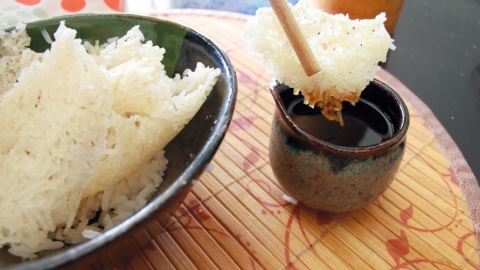The Secret Life of (Scorched) Rice
Growing up in an Asian family of 10, rice was a staple, one of those constants that defined my upbringing.
Mom didn’t buy rice from the store in the one-, two- or even five-pound bags. Dad brought it home in a canvas sack that contained 50-pounds of “Double-A Texas Long Grain.” We didn’t keep it in a canister or a jar; my parents dedicated a 16-inch-deep kitchen drawer to hold a whole bag’s worth of rice. I understood bulk bins long before I saw them as an adult at Whole Foods.
Rice was always there, the perfect second or third fiddle to any main dish. A lot like tofu, it soaked up the essence of whatever food was star of the show. Butter, curry, gravies and sauces (savory or sweet), au jus, ketchup (yes, rice took me through that phase too)—rice soaked up the flavors into a medium that helped forks, spoons and chopsticks effectively do their job of delivering the delight from plate to palate.
Rice was there in the Chinese cooking I grew up with; it was awesome in American dishes where each person had their own portion of meat and veggies; it was wonderful in paella, pilaf, burritos and stews; it was great fried, made into porridge or horchata or added to soup. It’s the unsung backbone of so many dishes, flavors and textures from all over the world.
But even rice has a hidden identity—that not-on-the-menu alterego that so many “insiders” feel is their family secret. It’s the crispy rice that cooks just a little too long on the bottom of the pot. While the rest of the rice is steaming happily and properly above, the stuff at the bottom gains a hardness, an edge, an attitude. Crunchy and crispy with a mild, toasted flavor, it still takes on any flavor, but the texture gives the same sublime munching satisfaction as chips, roasted nuts, chicharrones, toffee—you get the idea. Growing up, we called it “fon-ju.” after the term from my parents’ Cantonese-speaking Chinese village.
In college, my roommates didn’t understand why I didn’t just throw out the stuff that stuck to the bottom of the pot. “Why bother cooking it even more?” they’d ask. When my wife married me, I refused to get an automatic rice cooker because something was missing in that “perfect pot of rice every time.” Nowadays, there are automatic rice cookers with a crisping (okoge) function, but I still like to do it myself. Like with most masterpieces, careful and personal attention yields greatest satisfaction.
Talking to other people, I came to find that fon-ju—like “normal” rice—has a near-universal appeal. I have a friend who grew up in Colombia and spent a lot of her childhood helping in her grandmother’s restaurant kitchen. There was always a huge pot of rice cooking in chicken broth. When one pot was done, another would be started, but the first pot had to be cleaned out of all that crisped rice at the bottom. Evidently, taking care of the crisped rice was a chore she was more than eager to do. Other acquaintances with Near- and Middle-Eastern backgrounds talk about crisped rice dishes that never made it to become “leftovers.”
I remember when “sizzle soup” became a culinary fad in San Francisco’s Chinese restaurant scene. They pan-fried rice in oil, brought it to the table with a tureen of soup and scooped the rice into the soup, causing a noisy spectacle that retained its crunch, but only if you ate it fast enough.
So if crispy rice has this much appeal amongst people in my personal (non-epicurean) sphere, how widespread is its appeal outside my experience? And how is it that nobody seems to talk about their crispy rice dishes the same way they go on about more “gourmet” fare?
Well, for one, it is considered poverty food in some parts of the world. After that, I can only guess from experience. At home, fon-ju wasn’t a nightly thing; it felt more like a fortunate accident that I accidentally fell in love with. Fon-ju wasn’t how rice was supposed to be, so we didn’t make it on purpose—until we did. There you have it. My family’s dirty little secret. Maybe its pedestrian origins are why it doesn’t rate with the gourmand paparazzi.
Out of curiosity, I googled “crispy rice” and, later, “scorched rice.” It shows up as a key ingredient in foods from all over Asia, Southeast Asia, the Pacific Islands, the Middle East, Spain and Latin America. There’s com chay (Vietnam), guoba (China), okoge (Japan), nurungji (Korea), intip and rengginang (Indonesia), tutong (Philippines), tahdig (Iran), hikahkeh (Iraq), socarrat (Spain), cucayo (Colombia), pegao (Puerto Rico), concon (Dominican Republic), cocolon and raspado (Caribbean). And that’s not mentioning the various dishes that are made from the crispy rice. In Korea, it’s actually touted as a health aid for people with upset stomachs. Plus, there’re recipes for sushi lovers or vegetarians; recipes that include meats, eggs, tea and all manner of spice combinations, since the roasted rice takes on any flavor and adds its own crunchy, nutty component.
And these are not just obscure, accidental inventions from a few unknown people’s kitchens. These recipes have names and national traditions and a growing place in the hearts and stomachs of so many people that crispy rice can no longer be viewed as an accident.
At all. Ever.






